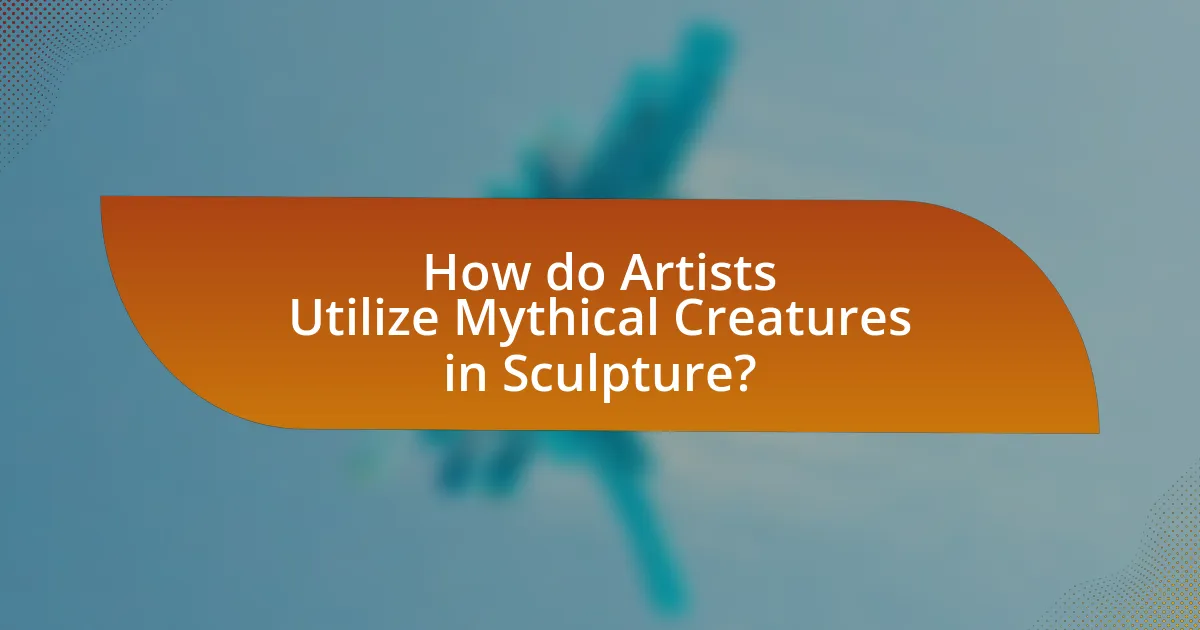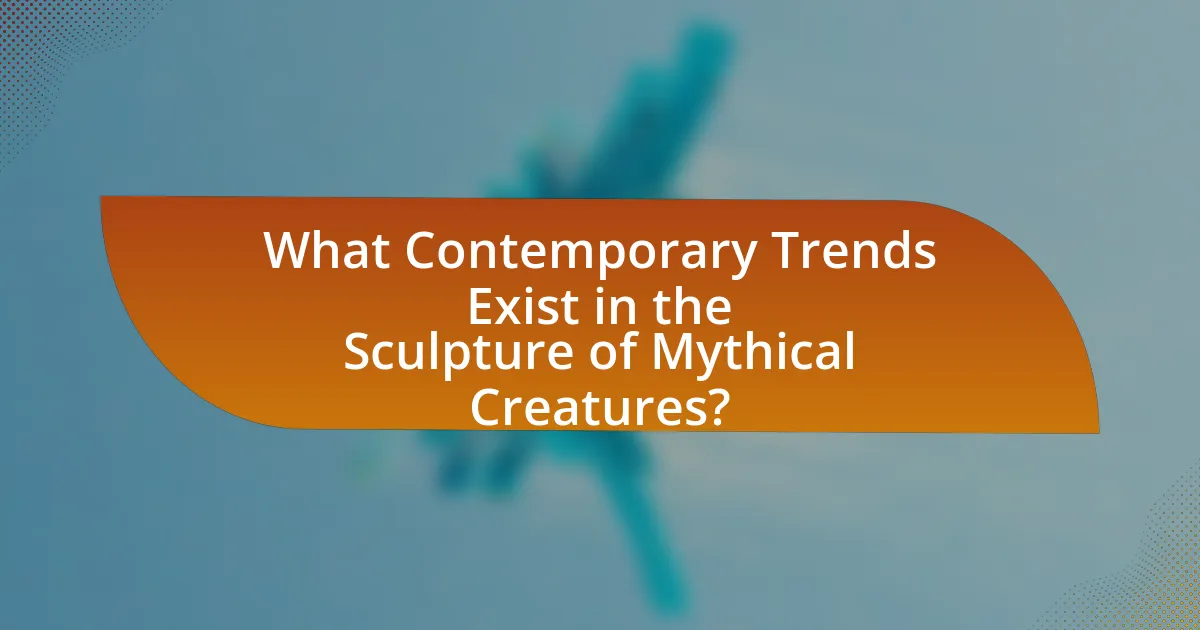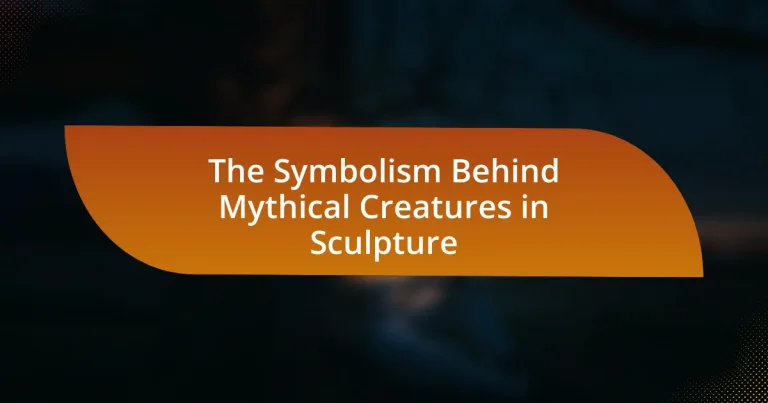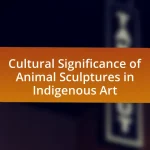The article explores the symbolism behind mythical creatures in sculpture, highlighting how these representations embody human emotions, ideals, and cultural narratives. It examines specific creatures such as dragons, griffins, unicorns, and mermaids, detailing their significance in various cultures and how they reflect societal values. The discussion includes the historical context influencing these symbols, the techniques artists use to depict them, and contemporary trends in sculpture that reinterpret these mythical beings. Additionally, the article addresses how modern societal issues shape the portrayal of mythical creatures, providing practical tips for artists in their creative processes.

What is the Symbolism Behind Mythical Creatures in Sculpture?
Mythical creatures in sculpture symbolize various human emotions, ideals, and cultural narratives. These representations often embody traits such as strength, wisdom, and mystery, reflecting the values and beliefs of the societies that create them. For example, dragons frequently symbolize power and protection in many cultures, while griffins represent the union of strength and intelligence. Historical evidence shows that ancient civilizations, such as the Greeks and Egyptians, used these creatures to convey moral lessons and spiritual beliefs, reinforcing their significance in art and culture.
How do mythical creatures represent cultural beliefs in sculpture?
Mythical creatures in sculpture represent cultural beliefs by embodying the values, fears, and aspirations of a society. For instance, dragons in Chinese culture symbolize power and good fortune, reflecting the importance of these traits in Chinese society. Similarly, the griffin, a creature with the body of a lion and the head of an eagle, represents strength and vigilance in various cultures, often associated with protection and guardianship. These representations serve as visual metaphors, allowing societies to communicate complex ideas and moral lessons through art. The prevalence of these creatures in historical artifacts, such as the ancient Greek sculptures of centaurs, further illustrates how they encapsulate human experiences and societal norms, reinforcing the cultural narratives that shape identity.
What specific mythical creatures are commonly depicted in sculptures?
Commonly depicted mythical creatures in sculptures include dragons, griffins, unicorns, and mermaids. Dragons are often represented in various cultures as symbols of power and wisdom, frequently seen in Asian and European art. Griffins, with the body of a lion and the head and wings of an eagle, symbolize strength and protection, appearing in ancient Greek and Roman sculptures. Unicorns, often associated with purity and grace, are depicted in medieval European art. Mermaids, representing the duality of human nature and the allure of the unknown, are prevalent in maritime sculptures. These creatures serve not only as artistic subjects but also convey deeper cultural meanings and values.
How do the characteristics of these creatures reflect societal values?
The characteristics of mythical creatures in sculpture reflect societal values by embodying cultural ideals, fears, and aspirations. For instance, dragons often symbolize power and strength, reflecting a society’s admiration for authority and dominance, while unicorns represent purity and innocence, highlighting the value placed on virtue and morality. Historical examples include the use of griffins in ancient art, which combined the strength of a lion and the wisdom of an eagle, symbolizing the ideal ruler’s qualities in various cultures. These representations serve as a mirror to the values and beliefs held by the society that created them, illustrating how art can encapsulate and communicate complex societal narratives.
Why are mythical creatures significant in artistic expression?
Mythical creatures are significant in artistic expression because they embody complex themes and emotions that resonate across cultures and time periods. These beings often symbolize the human experience, representing fears, desires, and moral lessons, which artists can explore through various mediums. For instance, dragons frequently symbolize power and chaos, while unicorns represent purity and innocence. The use of mythical creatures in sculpture allows artists to convey abstract concepts visually, making them accessible and relatable to audiences. Historical examples include the use of griffins in ancient Greek art, which symbolized strength and protection, illustrating how these creatures have been employed to communicate deeper meanings throughout history.
What emotions or ideas do these creatures convey through sculpture?
Mythical creatures in sculpture convey a range of emotions and ideas, including fear, wonder, and the duality of nature. For instance, dragons often symbolize power and chaos, evoking both admiration and trepidation due to their formidable presence in various cultures. Similarly, sculptures of unicorns represent purity and grace, instilling a sense of hope and enchantment. The representation of these creatures often reflects cultural beliefs and societal values, as seen in ancient Greek sculptures where centaurs embody the struggle between civilization and barbarism. This duality illustrates the complexities of human nature and the moral lessons embedded in mythology.
How do artists use mythical creatures to tell stories?
Artists use mythical creatures to convey complex narratives and themes, often representing human emotions, moral lessons, or cultural beliefs. By incorporating figures like dragons, unicorns, or griffins, artists tap into established mythologies that resonate with audiences, allowing for deeper engagement with the artwork. For instance, the dragon often symbolizes chaos or power, while the unicorn represents purity and innocence, enabling artists to explore contrasting ideas within a single piece. This use of symbolism is evident in historical sculptures, such as those from ancient Greece, where mythical beings were employed to illustrate tales from mythology, thereby enriching the storytelling aspect of the art.
What historical contexts influence the symbolism of mythical creatures?
Historical contexts that influence the symbolism of mythical creatures include ancient religious beliefs, cultural narratives, and societal values. For instance, in ancient Mesopotamia, creatures like the Lamassu symbolized protection and divine authority, reflecting the civilization’s emphasis on security and spirituality. Similarly, in Greek mythology, creatures such as the Minotaur represented the complexities of human nature and societal fears, illustrating how cultural narratives shape the interpretation of these beings. Additionally, during the Renaissance, mythical creatures in art often embodied humanist ideals, showcasing the era’s focus on individualism and the exploration of the human condition. These historical contexts provide a framework for understanding how mythical creatures serve as symbols that resonate with the values and beliefs of their respective cultures.
How have different cultures interpreted mythical creatures in their sculptures?
Different cultures have interpreted mythical creatures in their sculptures as embodiments of their values, beliefs, and natural phenomena. For instance, ancient Greek sculptures often depicted centaurs and griffins, symbolizing the duality of human nature and the power of the gods, respectively. In contrast, Chinese culture has represented dragons in their sculptures as symbols of strength, good fortune, and imperial authority, often seen in temples and palaces. Similarly, in Mesoamerican cultures, sculptures of feathered serpents like Quetzalcoatl reflect the integration of earth and sky, representing fertility and the cycle of life. These interpretations reveal how mythical creatures serve as cultural mirrors, reflecting the unique worldviews and societal norms of each civilization.
What role did mythology play in the development of sculpture styles?
Mythology significantly influenced the development of sculpture styles by providing a rich source of themes, narratives, and symbolic representations. Sculptors drew inspiration from mythological figures and stories, which allowed them to convey complex ideas and cultural values through their work. For instance, ancient Greek sculptures often depicted gods and heroes, such as the statue of Zeus at Olympia, which not only showcased artistic skill but also reflected the religious beliefs and societal ideals of the time. This integration of mythology into sculpture styles helped to establish a visual language that communicated shared cultural narratives, making the art form a vital medium for storytelling and expression in various civilizations.

How do Artists Utilize Mythical Creatures in Sculpture?
Artists utilize mythical creatures in sculpture to convey complex themes, emotions, and cultural narratives. By incorporating figures such as dragons, griffins, and unicorns, sculptors tap into the rich symbolism associated with these beings, often representing ideals like strength, wisdom, or purity. For instance, the dragon is frequently depicted as a guardian of treasures, symbolizing power and protection, while the unicorn often embodies innocence and beauty. Historical examples include the use of mythical creatures in ancient Greek and Roman sculptures, where they served not only decorative purposes but also conveyed moral and philosophical messages. This practice continues in contemporary art, where artists reinterpret these creatures to explore modern themes, reflecting society’s ongoing fascination with mythology and its relevance to human experience.
What techniques do artists employ to depict mythical creatures?
Artists employ various techniques to depict mythical creatures, including the use of symbolism, anatomical exaggeration, and mixed media. Symbolism allows artists to convey deeper meanings associated with the creatures, such as strength or wisdom, by incorporating specific attributes or colors. Anatomical exaggeration emphasizes certain features, like wings or scales, to enhance the fantastical elements of the creature, making it visually striking and memorable. Mixed media techniques, such as combining traditional sculpting materials with modern elements, enable artists to create unique textures and forms that further bring these mythical beings to life. These methods have been historically validated, as seen in ancient sculptures like the Greek Chimera, which utilized exaggerated forms to symbolize the creature’s ferocity and complexity.
How does material choice affect the representation of these creatures?
Material choice significantly influences the representation of mythical creatures in sculpture by affecting their visual characteristics, texture, and perceived symbolism. For instance, bronze conveys strength and permanence, often used for heroic figures, while softer materials like clay allow for intricate details that can evoke a sense of delicacy or vulnerability. Additionally, the choice of color and finish in materials like marble can enhance the ethereal qualities associated with mythical beings, reinforcing their otherworldly nature. Historical examples include the use of alabaster in ancient sculptures to create a luminous effect, symbolizing purity and divinity, which aligns with the characteristics attributed to many mythical creatures.
What styles are prevalent in the sculpture of mythical creatures?
The prevalent styles in the sculpture of mythical creatures include classical, Gothic, and contemporary styles. Classical sculptures often emphasize idealized forms and intricate details, as seen in ancient Greek and Roman works that depict gods and mythological beings. Gothic sculptures, characterized by elongated figures and dramatic expressions, often represent mythical creatures in a religious context, particularly in cathedrals. Contemporary styles, which can vary widely, often incorporate abstract forms and mixed media, reflecting modern interpretations of mythology. These styles collectively showcase the evolution of artistic expression and cultural significance attributed to mythical creatures throughout history.
Why do artists choose specific mythical creatures for their work?
Artists choose specific mythical creatures for their work to convey complex themes and emotions that resonate with cultural narratives. These creatures often symbolize various human experiences, such as fear, hope, or transformation, allowing artists to explore deeper meanings within their sculptures. For instance, dragons may represent power and chaos, while unicorns often symbolize purity and innocence. The selection of these creatures is influenced by historical context, cultural significance, and personal interpretation, enabling artists to connect with audiences on multiple levels.
What factors influence the selection of a creature in a sculpture?
The selection of a creature in a sculpture is influenced by cultural symbolism, artistic intent, and the intended message. Cultural symbolism plays a significant role, as different creatures carry specific meanings across various societies; for example, dragons often symbolize power and strength in many cultures. Artistic intent is another factor, as the sculptor may choose a creature that aligns with their vision or the theme of the artwork, such as using a phoenix to represent rebirth. Additionally, the intended message of the sculpture can dictate the choice of creature, as certain animals may evoke specific emotions or ideas, like using a lion to convey courage. These factors collectively guide the selection process, ensuring that the chosen creature resonates with the audience and fulfills the artistic purpose.
How does the intended message shape the choice of mythical creature?
The intended message significantly influences the choice of mythical creature by aligning the creature’s attributes with the themes or values the creator wishes to convey. For instance, a sculpture featuring a dragon may symbolize power and strength, reflecting a message of dominance or protection, while a unicorn might represent purity and innocence, aligning with themes of hope or beauty. Historical examples include the use of griffins in ancient art to symbolize divine protection, indicating that the choice of creature is often deliberate and contextually relevant to the intended narrative or moral lesson.

What Contemporary Trends Exist in the Sculpture of Mythical Creatures?
Contemporary trends in the sculpture of mythical creatures include a focus on sustainability, the use of mixed media, and the incorporation of technology. Artists increasingly utilize eco-friendly materials, reflecting a growing awareness of environmental issues, as seen in works by artists like Chris Drury, who combines natural elements with traditional sculpting techniques. Additionally, mixed media approaches allow for innovative expressions, blending traditional sculpture with digital elements, as demonstrated by artists such as KAWS, who reinterprets mythical figures through a modern lens. Furthermore, the integration of augmented reality and interactive installations is becoming prevalent, allowing audiences to engage with sculptures in dynamic ways, as evidenced by projects like “The Immersive Museum” in Tokyo, which merges physical sculptures with digital experiences. These trends highlight a shift towards more interactive, environmentally conscious, and technologically integrated representations of mythical creatures in contemporary sculpture.
How are modern artists reinterpreting mythical creatures in their work?
Modern artists are reinterpreting mythical creatures by blending traditional symbolism with contemporary themes and mediums. For instance, artists like Takashi Murakami incorporate elements of Japanese folklore into vibrant, pop-art styles, creating a dialogue between ancient myths and modern consumer culture. Additionally, sculptors such as Kiki Smith utilize materials like bronze and glass to explore themes of femininity and nature through figures inspired by mythological beings, thereby challenging conventional narratives. This approach not only revitalizes the significance of these creatures but also reflects current societal issues, making them relevant in today’s artistic landscape.
What new materials and technologies are being used in these sculptures?
New materials and technologies being used in contemporary sculptures include 3D printing, augmented reality, and sustainable materials like bioplastics. 3D printing allows artists to create intricate designs that were previously impossible with traditional methods, enabling precise replication and customization. Augmented reality enhances the viewer’s experience by overlaying digital elements onto physical sculptures, creating an interactive dimension. Sustainable materials, such as bioplastics, are increasingly favored for their reduced environmental impact, aligning with modern ecological values. These advancements reflect a shift towards innovation and sustainability in the art world.
How do contemporary societal issues influence the depiction of mythical creatures?
Contemporary societal issues significantly influence the depiction of mythical creatures by reflecting current cultural anxieties, values, and social dynamics. For instance, the rise of environmental concerns has led to the portrayal of mythical creatures like mermaids and dragons as symbols of nature’s fragility and the consequences of climate change. This shift is evident in modern art and literature, where these beings often embody the struggle between humanity and the environment, illustrating the urgency of ecological preservation. Additionally, issues such as gender identity and representation have transformed the depiction of creatures like fairies and centaurs, allowing for more diverse and inclusive interpretations that challenge traditional norms. This evolution in representation aligns with societal movements advocating for equality and acceptance, showcasing how mythical creatures serve as mirrors to contemporary social issues.
What are some notable examples of recent sculptures featuring mythical creatures?
Recent notable sculptures featuring mythical creatures include “The Kraken” by artist David Cerny, displayed in Prague, which represents the legendary sea monster and explores themes of fear and the unknown. Another example is “The Dragon” by artist Ai Weiwei, showcased in London, symbolizing power and protection in Chinese culture. Additionally, “The Phoenix” by artist Xu Bing, located in New York, embodies rebirth and transformation, drawing from Chinese mythology. These sculptures not only depict mythical beings but also convey deeper cultural meanings and narratives associated with them.
How do these examples reflect current artistic trends and themes?
These examples reflect current artistic trends and themes by showcasing the integration of mythology with contemporary issues, such as identity and environmental concerns. Artists are increasingly using mythical creatures to symbolize complex narratives that resonate with modern audiences, illustrating how ancient symbols can be reinterpreted to address today’s societal challenges. For instance, sculptures depicting creatures like dragons or phoenixes often embody themes of transformation and resilience, mirroring the current focus on personal and collective evolution in art. This trend aligns with the broader movement towards blending traditional motifs with modern contexts, emphasizing the relevance of mythology in contemporary discourse.
What practical tips can artists follow when creating sculptures of mythical creatures?
Artists creating sculptures of mythical creatures should focus on thorough research of the creature’s mythology and symbolism to ensure authenticity and depth in their work. Understanding the cultural significance and characteristics of the creature allows artists to incorporate meaningful details that resonate with viewers. For example, studying ancient texts or folklore can provide insights into the creature’s traits, which can be reflected in the sculpture’s posture, expression, and materials used. Additionally, artists should experiment with various materials, such as clay, metal, or stone, to find the best medium that captures the essence of the mythical creature. Utilizing techniques like sketching and modeling can help visualize the final piece and refine the design. Engaging with other artists or communities can also provide valuable feedback and inspiration, enhancing the creative process.


